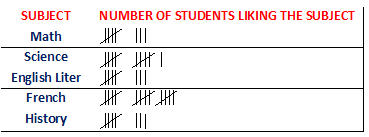CLASS-4
PICTOGRAPH - TALLY MARKS
TALLY MARKS -
Another way of representing large data is tally marks. Here numbers are represented in a groups of five by drawing lines. One vertical lines is made for each of the first four numbers and the fifth number is represented by a diagonal line across the previous four vertical lines.
Tally marks are a simple way of keeping track of numbers. They are used in arithmetic to represent a count of items or occurrences. Tally marks are typically made by drawing vertical lines or slashes, with every fifth mark drawn diagonally across the previous four to make a bundle of five.
For example, to represent the number "4" using tally marks, you would draw four vertical lines with a diagonal slash across the fourth line to make a bundle: ||||
Similarly, to represent the number "8" using tally marks, you would draw two bundles of five and then three additional vertical lines:
|||| / |||
Tally marks are useful for counting and adding small numbers quickly and efficiently. They can also be used to represent larger numbers by grouping bundles of five and then counting the remaining individual marks.
Tally marks are a form of notation used for counting. They are commonly used to keep track of scores, quantities, or other numerical data. Tally marks are typically represented by vertical strokes or slashes that are made on a piece of paper or other surface.
The standard way to represent tally marks is to make a vertical line for each count, and then group the lines in groups of five, with a diagonal line drawn across the group of four lines to represent the fifth count. This helps to keep track of the number of tallies easily and quickly.
For example, if you wanted to keep track of the number of times you had performed a particular task, you might use tally marks to keep track of the count. Each time you performed the task, you would make a tally mark, and then group the marks in groups of five. After you had made four marks, you would draw a diagonal line across them to indicate the fifth mark, and then start a new group.
Tally marks are a simple and effective way to keep track of numerical data, and are often used in situations where a quick and easy visual representation of the data is needed.
Tally marks are a way of keeping track of counting by using vertical lines. Each mark represents one count, and after every fifth mark, a diagonal line is added to show the completion of a set of five. Tally marks are commonly used in various fields such as education, sports, and surveys. Here's an example of tally marks:
|||| (represents 4)
||| (represents 3)
|||| / (represents 5, or a completed set of 5 tally marks)
Tally marks are a system of counting that uses vertical lines or strokes to represent numbers. They are commonly used for counting and recording numerical data, especially when working with small numbers.
To create a tally mark, a vertical line or stroke is drawn, usually on a piece of paper or other surface. The first four marks are usually drawn vertically, with the fifth mark drawn diagonally across the previous four marks. This pattern is then repeated for each group of five, allowing for easy counting and totaling of numbers.
For example, to represent the number 7 using tally marks, you would draw two vertical lines, then cross them with a diagonal line to indicate the fifth mark, and then draw two more vertical lines, as follows:
|||| / ||
This represents a count of five (|||| /), followed by two more vertical lines (||), for a total count of 7.
Tally marks can also be used in more complex ways, such as to represent fractions or to keep track of voting results.
Example.1) There are 50 students in a class, students have different favorite. The representation below shows the detailed information of the data. Read the data and answer the following question.

Make a table and answer the following questions in full sentences.
SUBJECT NO. OF STUDENTS LIKING THE SUBJECT
Math 8
Science 11
English Literature 8
French 15
History 8
1. Which is students’ most favorite subject?
Ans: French is students’ most favorite subject (15).
2. How many students like Science?
Ans: Eleven (11) students like Science.
3. How many students like English Literature?
Ans: Eight (8) students like English Literature.
4. How many students like History and Science?
Ans: Eight students like History and eleven students like Science.
Total 8 + 11 = 19
Nineteen (19) students like History and Science.